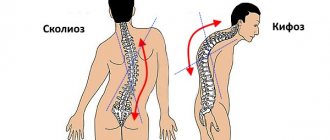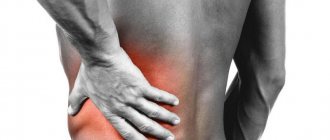Patients with advanced cases of osteochondrosis often develop a natural complication - radiculitis. This is a condition in which the radicular nerves that extend from the spinal cord structure become inflamed. Is it possible to warm your back with radiculitis, take a bath, go to the bathhouse and steam there, visit your place of work - these and many questions arise acutely for anyone who is faced with a similar disease.
We propose to understand in detail what can be done for radiculitis, and what is best avoided. This article contains the most popular questions from patients. Recommendations for carrying out comprehensive effective treatment are also provided.
What is sciatica?
First, let's figure out what sciatica is and why it occurs. This is an inflammatory process, as indicated by the suffix -itis, of the radicular nerves (in Latin they are called radiculi). The inflammation is usually of an aseptic compression nature. Those. For its development, it is necessary that compression pressure begins to be exerted on the radicular nerve, as a result of which a disruption of the blood supply occurs and, against the background of ischemia, a compensatory type of inflammatory reaction is triggered.
Such phenomena usually accompany the following pathologies of the spinal column:
- osteochondrosis is a degenerative dystrophic process leading to the destruction of the fibrous ring of the intervertebral disc, associated with severe compression of the radicular nerves;
- protrusion and extrusion of the intervertebral disc is a complication of osteochondrosis;
- intervertebral hernia - puts pressure on the radicular nerve and causes secondary inflammation due to the irritating effect of the nucleus pulposus;
- spondyloarthritis and spondylosis are diseases that provoke impaired mobility in the intervertebral facet joints;
- spondylolisthesis – displacement and instability of the position of the vertebral bodies, leading to compression of the radicular nerves;
- Ankylosing spondylitis (ankylosing spondylitis);
- systemic lupus erythematosus;
- spine and spinal cord injuries;
- sprains, ruptures and cicatricial deformities of the ligamentous and tendon apparatus along the spinal column;
- tuberculosis and tumors of the spinal cord and tissues of the spinal column.
With radiculitis, severe pain syndrome is observed, pain irradiates along the affected nerve fiber, numbness of some parts of the body, decreased muscle strength, paresthesia and other neurological manifestations. If timely medical care is not provided, then the consequence of radiculitis is pathological overstrain of the muscle fiber, which further contributes to compression of the roots.
Complex treatment of radiculitis should be based on eliminating the action of the pathogenic factor. Those. First you need to eliminate the cause of the inflammatory reaction - pressure on the radicular nerve. If it is osteochondrosis, protrusion, extrusion or disc herniation, then it is recommended to first conduct several sessions of traction traction of the spinal column. This procedure will increase the spaces between adjacent vertebral bodies, restore the physiological shape of the intervertebral discs and relieve pressure from the radicular nerves.
Then the doctor develops an individual course of treatment, which may include osteopathy, massage, therapeutic exercises, kinesiotherapy, physiotherapy, reflexology, etc.
If you need effective and safe medical care for radiculitis, then you can make a free appointment with a vertebrologist right now. At our manual therapy clinic in Moscow, doctors provide a free first appointment for each patient. During the consultation, an examination is carried out and the results of examinations already carried out are reviewed. After an accurate diagnosis is made, an individual course of therapy is developed.
Diagnostics
Treatment of radiculitis begins with a visit to a neurologist. A specialist’s diagnosis includes an analysis of concomitant diseases, symptoms and the nature of pain. If necessary, additional studies are prescribed:
1. General and biochemical blood test. Shows the presence of inflammation in the body.
2. Radiography. It will help determine the presence of fractures, cracks and tumors.
3. Spinal puncture. Determines the acidity of cerebrospinal fluid.
4. Myelography. A contrast agent is injected into the cerebrospinal fluid, tracking the movement of which can detect disorders occurring inside the spine.
5. Ultrasound. Allows you to exclude diseases of internal organs and examine the condition of blood vessels.
6. CT. Able to accurately indicate the degree of compression of nerve fibers.
7. MRI. It is considered the most effective method in diagnosing radiculitis.
Is it possible to go to the bathhouse and take a steam bath if you have radiculitis?
Whether it is possible to go to the bathhouse with radiculitis depends on the condition of the patient and what type of establishment you plan to visit. If this is a classic Russian steam room with a high level of humidity, then it is better not to risk it. Such a visit can lead to even greater pain. But you can visit the Turkish hammam.
Some doctors claim that you can steam with radiculitis and it even brings certain benefits. This is a very controversial issue. Whether it is possible to steam with radiculitis depends again on the person’s condition and the degree of exacerbation of the disease. In the acute period, any such procedures are strictly prohibited, since a huge number of inflammatory reaction factors accumulate in the area of nerve fiber compression. When exposed to hot air, they quickly spread throughout the surrounding soft tissues and the patient's condition deteriorates sharply.
You can take a steam bath for radiculitis only if all acute inflammatory processes have already been stopped and compression on the nerve fiber has been eliminated. It is necessary to agree with your doctor whether it is possible to take a steam bath if you have radiculitis and at what point it is better to start such procedures.
In most cases, with radiculitis, you can go to the bathhouse during periods of remission - when all the symptoms of osteochondrosis are eliminated, the person feels the complete well-being of his health. There is no pain (even minor), stiffness of movement, numbness, etc. With this state of health, if you have had an attack of radiculitis in the recent past, you can go to any bathhouse and steam there with any broom. But it is better to give preference to a Finnish sauna. There is no high level of humidity, and dry hot air has a more positive effect on the musculoskeletal system of the human body.
As you can see, the answer to the question of whether it is possible to go to the bathhouse with radiculitis is not unambiguous and does not apply to all situations. Usually you should approach this issue individually. If a person does not have a risk of developing an intervertebral hernia, compression of the radicular nerve is not very pronounced and is not detected by muscle fiber tension, then most likely he may be shown a steam room as an auxiliary therapeutic agent
Symptoms and signs
Treatment for radiculitis is selected based on the symptoms present in a particular patient. The distribution of pain directly depends on the location of the damaged nerve. With lumbar radiculitis, there is numbness and tension in the pelvic organs and lower extremities, while cervical radiculitis manifests itself with headaches and impaired consciousness. An attack of sciatica usually occurs suddenly and affects only one side of the human body. In this case, you can reduce pain by taking a certain position of the body in space, and coughing and sneezing can greatly increase the pain.
Symptoms of cervical radiculitis
Before starting treatment for radiculitis in the cervical spine, pay attention to the following manifestations:
1. Presence of pain in the back of the head and neck.
2. Presence of burning, numbness or tingling in the affected area.
3. Prevalence of pain (half of the arm or to the fingertips).
4. Hypersensitivity.
5. Restriction of the ability to move the affected parts of the body.
Analysis of these signs gives the doctor an idea of the strength of pathological changes and allows for more accurate selection of therapy.
Symptoms of thoracic radiculitis
Treatment of thoracic radiculitis begins with diagnosing the functioning of internal organs, primarily the heart, stomach and lungs. This is due to the fact that pain from compression of the nerve endings of the spine in this area can be disguised as various diseases. Main symptoms:
1. Hypersensitivity.
2. Decreased muscle tone.
3. Weakening of reflexes.
Symptoms of lumbosacral radiculitis
When choosing treatment methods for radiculitis of the lumbosacral region, the doctor pays attention to the nature and distribution of the pain syndrome. Radiculitis can occur as follows:
1. Lumbago. When the lower back hurts directly.
2. Lumboischialgia. In addition to the lower back, the hip, sacrum and lower leg are affected.
3. Sciatica. The pain radiates to the buttock and leg in the direction of the sciatic nerve.
Is it possible to take a bath with radiculitis?
Another common question concerns whether it is possible to take a bath with radiculitis during an exacerbation, since not everyone has the opportunity to perform hygiene procedures in the shower.
The answer is clear: you can take a bath with radiculitis, but the water temperature should not exceed 40 ° C and the duration of water procedures should not last longer than 15 minutes. Lying in a bathtub filled with water, which gradually cools down, is strictly contraindicated; this can provoke increased pain and increase the level of muscle fiber tension in the area of compression.
Is it possible to do massage with radiculitis?
Is it possible to do massage for radiculitis yourself? The answer is categorically negative. Any manual impact on the area of damaged intervertebral discs can lead to catastrophic health consequences.
Is it possible to get a massage for radiculitis in massage and beauty salons? If employees without special medical education work there, then it is impossible. This can also lead to negative consequences.
The only place where you can get a massage for radiculitis is specialized clinics or rehabilitation departments at city clinics. The procedure must be carried out by a specialist with a medical education, certificate and certificate of completion of professional training courses. All other persons, even doctors, are not allowed to carry out such manipulations. That is, if a specialist has not completed a training course in conducting therapeutic massage, then he does not have the right to perform it.
Our manual therapy clinic employs experienced massage therapists who have medical education and have completed special professional training courses. Massage is a basic part of the effective treatment of radiculitis and osteochondrosis, protrusion or intervertebral hernia that provokes it.
Types of radiculopathy
Classification of radiculitis in domestic medicine is made according to the area of localization and is divided into:
1. Primary form (cervical, lumbar and thoracic radiculitis)
2. Secondary form (thoracolumbar, cervicothoracic, lumbar radiculitis).
The disease was assigned an ICD-10 code - M54.1, which denotes brachial, thoracic, lumbar and lumbosacral radiculitis. Thoracic radiculopathy is considered the rarest type, cervical radiculopathy is much more common, and lumbosacral radiculitis is diagnosed in 80% of cases.
Is it possible to warm the back with radiculitis and apply mustard plasters?
The question of whether it is possible to heat a sore spot with radiculitis depends on the circumstances. If it is dry, low-intensity heat, then yes, the procedure will have a beneficial effect on the condition of the inflamed tissues. But using various compresses, heating pads, and hot irons is not only not advisable, but also contraindicated.
For radiculitis, you can heat it with ozokerite, a bag filled with hot salt, UHF, magnet, etc. Also, for radiculitis, you can warm your back using dog hair belts. But the use of various alcohol tinctures is prohibited.
If you have any other methods, then consult your doctor about whether you can warm your back with radiculitis using a similar method. You can also contact us using the feedback form. We will try to answer it as objectively as possible.
We are also often asked whether it is possible to place mustard plasters on a sore spot for radiculitis and whether this procedure helps in treatment. Mustard is a local irritant that causes a reflex expansion of small blood vessels in the thickness of the epidermis. Due to the influx of fresh capillary blood, damaged cells are restored faster and pain is relieved. Therefore, mustard plasters can be used, but be careful not to cause a skin burn. At the site of compression of the radicular nerve, skin sensitivity may be reduced and a person may not feel the moment when a chemical skin burn reaction develops.
Is it possible to walk and work with radiculitis?
The question of whether it is possible to walk with radiculitis is asked by patients who, in principle, have not encountered such a complication of osteochondrosis. The fact is that even with a strong desire to walk fully, a patient with inflammation of the radicular nerves will not be able to walk. Muscle tone decreases, it seems that the legs do not obey. Therefore, it is certainly possible to walk with radiculitis, but why is it necessary?
Another common question: is it possible to work with radiculitis? No, you cannot work during an exacerbation of osteochondrosis. The patient is given a certificate of temporary incapacity for work for the entire period of therapy, bed rest and limited physical activity are prescribed, since the risk of developing an intervertebral hernia is high. Complete compression of the radicular nerve, which can occur if this recommendation is not followed, will lead to paralysis of the upper or lower extremities.
If you still have questions about the treatment of radiculitis, you can ask them in a special form on the questions to the doctor page. If you need safe and effective treatment for osteochondrosis complicated by radiculitis and relieve pain without the use of pharmacological drugs, you can make an initial free appointment with our vertebrologist. The doctor will conduct an examination, make an accurate diagnosis and develop an individual course of therapy.
All services and pricesMake an appointment
Next article —>
What painkillers are available for spinal osteochondrosis?









